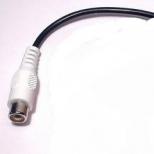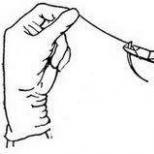How the largest ice rink in the world works. The cost of synthetic ice and additional equipment Artificial ice rink in the sun
Designed for indoor use with a stable temperature and a perfectly flat, solid base. Artificial ice rink from plastic ice model "Inside" is great for use in the training process of hockey players and figure skaters at home. The cost of this model is comparable to the cost of domestic counterparts made from low-quality raw materials - low-pressure polyethylene (HDPE), however, the quality of sliding is several times higher. Here you can buy artificial ice for hockey from German raw materials - high molecular weight polyethylene.
- Dimensions of one panel - 1966x996x10mm.
- Does not require the use of any lubricating emulsions.
- Has a puzzle-type fastening system - "dovetail".
- Life time artificial ice"Inside" models - up to 10 years.
Synthetic ice Slide Ice "Outside"
Suitable for both indoor and outdoor use. This model does not require a perfectly flat base for the roller, thanks to the unique for the Russian market system of panel fastening - "thorn-groove-pin". Such a system for connecting sheets eliminates the possibility of gaps between them. Also, the "Outside" model has UV protection from the sun, which prevents micro cracks and discoloration of the material. You can buy artificial ice from us inexpensively, because the price of "Outside" synthetic ice is more than two times lower than the cost of foreign analogues of absolutely the same quality.
- Dimensions of one panel - 1990x990x12.7mm.
- Does not require the use of any lubricating emulsions.
- Has a panel coupling system - "tongue-groove-pin".
- Service life of plastic ice model "Outside" - up to 15 years.

Decorative board "RIO"
Decorative board "RIO". The skating rink guard of the "RIO" model is intended for indoor or outdoor use. The board is made of a one-piece metal frame, consisting of three horizontal and three vertical profiles and anti-vandal monolithic polycarbonate, which does not break or crack even after a strong impact on it. The main advantage of such a board is that it does not need to be fixed to the base of the roller, which makes it versatile in use.
- You can choose any color of the frame and polycarbonate.
- Service life - unlimited.

Decorative board "Magnet"
The fencing of the "Magnet" skating rink is also suitable for indoor or outdoor installation. The product is assembled from a solid metal frame, consisting of two vertical, three horizontal profiles and two jibs, providing reliable, rigid stability. The inner lining is made of injection-molded anti-vandal 4mm polycarbonate. The fence does not require rigid fixation to the base, which allows it to be used without harming the floor covering.
- Dimensions of one section - 2000x1000mm.
- You can choose the frame and polycarbonate of any color.
- Has no restrictions on the service life.

In addition to the production of basic goods, our company is engaged in the supply of related additional equipment for the full organization of the ice rink. We can completely install the ice rink and provide it with everything you need "from A to Z", including: a set of skates different sizes, blade sharpener, cleaning machine polymer coating, skate counter, storage cabinets, shoe changing shops, rubber mats and much more.
- A set of men's, women's and children's skates - 50 pairs.
- Left-luggage offices - from 8 cells.
- Ice scrubber.

For those who are considering the possibility of installing a temporary ice rink, we offer the service of renting an ice rink made of plastic ice. Such a service is perfect for organizing mass skating during the celebration of a New Year's corporate party, a children's Christmas tree, a show with figure skaters or, for example, for opening a commercial ice rink in a shopping and entertainment center, city park or other public place.
- We will fully organize a skating rink with all the necessary equipment.
- We offer new or little-used ice in perfect condition.
- We have the most low price on the market thanks to our system of discounts.
Surely, each of you at least once attended an event on artificial ice - be it a hockey match, figure skating competition or just group skating.
Here I would like to tell you about reverse side obtaining artificial ice, for example, a small ice complex.
As a rule, we do not go beyond the rental of skating rinks and the ice itself. I invite you to visit the heart of the ice rink - the room where the refrigeration equipment is located. Usually no one thinks about how a stable artificial ice cover is obtained and due to which it is maintained even at positive ambient temperatures.
General information:
This ice rink located in Aleksandrovsk Perm Territory... In recent years, several similar skating rinks have been built and are already in operation in the region in small district towns and villages ..
Talking to people - a small town was waiting for the opening of the ice rink with great impatience
No ice at all - an artificial ice rink is a smooth concrete surface. But inside it is a whole layer cake - pipes are laid in concrete layers where a liquid coolant flows.
As a rule, in Russia, a 40% aqueous solution of ethylene glycol (hereinafter simply glycol) is used as a coolant for ice fields.
Almost any motorist knows what it is - in cars, glycol solutions are known as antifreeze.
Under it, more layers of heat and vapor insulation are laid, and then another concrete layer with pipes for heating the soil from freezing. These layers are needed so that the soil under the ice field does not freeze and swell. If this had not happened, we would have got permafrost under the ice layer - with all the ensuing consequences: swelling and uplift of the soil.
The pipelines in the field itself are made of polyethylene pipes. The diameter of the tubes is only 25 mm. Collectors are laid out along the long edges of the field and these pipes are scattered between them.
Glycol with a temperature of -12 degrees C is supplied to the pipe system of the ice field, at the exit from the field its temperature should be - 9 degrees C.
Freon R404a was used as a refrigerant. Cooling agent for ice field and ground heating 40% ethylene glycol water solution.
Refrigeration center (room where refrigeration equipment is located):
The heart of any ice rink is often called by different names: the refrigeration center, the room of the refrigeration unit, etc., it all depends on the imagination of the designer or architect). Almost all the main equipment of the refrigeration system is located there.
For the installation of glycol pipes, steel pipes, for freon - copper.
Photo - General view of the refrigeration center

In the foreground are the pumps: field cooling systems (main and standby) - they are recognizable by their black insulated pipelines, a soil heating pump and a small pump for replenishing / filling the system.
A total of 4 pieces.
The pumps provide circulation of the coolant (coolant) through the pipeline systems and through the tubes of the ice field.
On the right is the refrigeration machine itself - more about it below.
It can be seen that the pipelines and fittings of a 40% aqueous solution of ethylene glycol are made in foam rubber insulation. This is done in order to avoid condensation from the air on the cold surface of the pipes.
Photo - Pumps of the main contour of the ice field. In the background is the control panel for all pumps.

Photo - General view of the refrigeration machine

The refrigerating machine itself: in it, the glycol is directly cooled in a shell-and-tube heat exchanger (at the bottom of the machine itself) - it acts as an evaporator, where, due to the boiling of freon, heat is removed from the glycol circulating in the field. The movement of gaseous freon through the system is carried out by two screw compressors (green in the background).
In a shell-and-tube heat exchanger, freon boils - during boiling, heat is taken from the glycol and cooled. Freon, on the other hand, turns from a liquid state into a gas and is pumped into condensers by compressors.
The photographs show thermometers - they are installed to visually monitor the temperatures of liquids at the inlets / outlets of heat exchangers.
Also, the chiller is used to maintain the temperature inside
The red and blue piping suitable for the plate heat exchanger are the piping of the ground heating system, which also uses a 40% aqueous solution of ethylene glycol.
A plate heat exchanger in this case is a recuperator: for the glycol of the soil heating system, the heat of hot gaseous freon is used - at discharge it has a temperature of about 90 degrees C.
A control panel is installed on the right side of the frame - all temperature parameters of the unit are set on it.
Photo - Condenser area

To remove heat from the ice field in environment capacitors are used. In this case, air cooling. Freon condenses in them - it passes from a gaseous state to a liquid. After the condensers, it is already in a liquid state again enters the shell-and-tube evaporator and the cycle is repeated again.
Photo- Condenser close up

The condenser is a copper heat exchanger with fans (to forcibly increase the heat exchange efficiency). Here, the fans are covered with snow. the system did not start for a long time.
Photo - Skating

If you have any questions, I am ready to answer them in the comments.
Many are interested in whether it is realistic to make a skating rink out of synthetic ice with their own hands. It turns out to be pretty simple!
Everyone likes ice rinks, but they have a big limitation, because ice does not melt only at negative temperatures. Usually skating rinks are flooded with water in winter, right on the street. Thanks to natural freezing processes, ice forms, and the more or less flat surface of the site provides good sliding. People living in the countryside can fill their own grounds on their site and prepare places for them, but what to do for the rest of the year when there is no frost, because putting off skates is not an option.
The only thing that comes to mind is the installation of a specialized refrigeration equipment? The answer is incorrect, this equipment will be prohibitively expensive to purchase and maintain, not affordable to an ordinary person, and it is pointless, as a rule, such equipment is installed in a closed pavilion and there will be no room for it at home, moreover, it is not so small.

The solution will be to install synthetic ice and a skating rink, which will not require any additional investments, except for the cost of materials and, possibly, initial installation work. In addition, such playgrounds are especially useful for children. Unlike ice surfaces, on these, they can play for hours with friends without fear of catching a cold.
Seat selection
First you need to understand what will happen when the construction is completed? There will be a section made from blocks of synthetic ice. Basically, it can be located anywhere: at home, on the street, in any room or basement. It is not particularly affected by the sun or humidity or frost. Thus, artificial ice is completely universal for weather conditions, but in addition, it can also be disassembled and moved from an indoor area (in winter) to an open area (in summer), for example. All this is possible due to the fact that the whole process takes very little time. But let's start in order. In order to build a site, first we determine the place, for example, this is the garden of a country house.

The first step is to drop the surface. To do this, you can install any simple flooring made of boards or plywood, or even pour concrete, the main thing is that there is a flat, rigid and non-deformable surface.
Material selection
The choice of material is also an important task. All materials from which synthetic ice is created are polyethylene in one form or another. In order for the sheets to have good sliding, the most dense material is needed, like UHMWPE (Ultra High Molecular Weight Polyethylene) and others. Let's say the difference between PE500 (polyethylene) and PE1000 and higher (UHMWPE) will be significant. However, there will also be a difference in the price of the material, so it is better to choose according to your taste and wallet.

Models of sheets, on which the sliding is worse, are usually lubricated with additional silicone grease, which improves sliding. Conventional HDPE (Low Pressure Polyethylene) is also sold under the guise of synthetic ice. You can play ice hockey on it, but it is better without skates, but on roller skates. Various models of high molecular weight polyethylene will do much better with this task with or without added lubricant.
There are sheets of branded western ice, they can go like PE5000 and PE7000, you can skate on them almost like on ice, but such polymer sheets are already expensive.

But despite the difference in glide quality, any material will last long years... And even if one of the surfaces is worn out, you can easily turn the sheet over, after which it will be like new.
Installation of synthetic ice
Installation of sheets of synthetic ice from any material is very simple, even without the need to call specialists. In fact, no special tools are needed. The ice rink is laid out with ordered sheets of ice, which are fastened together with grooves, just like paper puzzles.

Usually, it takes only one to two hours to lay out an area of synthetic ice. If the surface is flat, then after one sheet fits into the grooves of the other, then their joint line will practically not be visible, at least from a short distance. In order for the sheets to go into the grooves, a special "soft" hammer is used, which does not damage the plastic, but gives a sufficient impact force.
Installation of sides
After all sheets of synthetic ice have been installed, an area will be formed. In principle, it is already possible to stop at this if private use is assumed and no one is bothered by the lack of boards. But if some semblance of a real ice rink is being created, or children, for example, will actively play hockey, then the sides will need to be made.
The sides are made of another material, most often ordinary HDPE or fiberglass (depending on the need to withstand ultra-high loads, professional level or not). The main problem is that all sheets are created for hockey rinks and ice rinks. standard sizes, which may not suit you personally. In this case, the rounded sheets will have to be ordered somewhere separately, or the platform will have to be made exclusively of rectangular shape.

The sheets must be securely fixed in several places along the entire length of the sheet, and also fixed with special stands behind them. In a word, the more the area resembles a hockey one, the more additional work... It may take the hands and tools of specialists to install the advanced boards.
Caring for the finished ice rink
A synthetic ice rink requires minimal maintenance, unlike a real ice rink. It is imperative to remove dust, sand and other small particles at a constant frequency, otherwise they will give an additional load on the wear of the smooth sliding surface.
If necessary (depending on the degree of wear and type of material), it is also necessary to lubricate the surface with silicone 2-4 times. This will improve glide and extend the life of the coating.

In addition to a vacuum cleaner to remove dust and sand, the surface should also be damp cleaned several times a year, together with the use of a detergent. Of course, the substance should not contain aggressive acids and should be suitable for plastic surfaces.
Thus, from the delivery of sheets to the formation of a skating rink with your own hands, it takes from several hours to a couple of days. After that, the site can be used for many years and, if necessary, rebuild it in another place.




